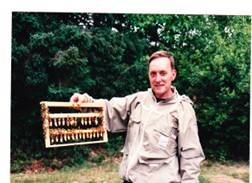Meet a Beekeeper
Don Amirault- The Intentional Beekeeper
Don Amirault became an accidental beekeeper at age twelve, then, at age fifty, after a long hiatus, he became a beekeeper again – intentionally. When he was a twelve year old living in Digby, a priest, newly assigned to the community asked Don's dad for a place to keep his three hives. A month later the priest offered the hives to twelve year old Don, who accepted and kept them for about ten years until he joined the RCAF in 1962. Don's early mentor was Jack Russell, a Digby land surveyor, who gave him Endel Karmo's "Beekeeping in Nova Scotia" for a text and helped him look after his bees and extract his honey. After Don joined the air force his bees didn't fare so well. He had given the hives to his brother, but when someone torched the field where they were kept, the bees perished. Don, meanwhile did basic training, then trained as a radar tech and was variously posted to Greenwood, Trenton, Winnipeg and Geilenkirchen in Germany before returning to Greenwood in 1986. Back in Greenwood he bought two packages and started catching swarms and making splits and in 1990 he started queen-rearing – an activity that combined his interest in bees with trying new and exacting things. Don soon teamed up with Norm Donovan who also worked at Greenwood. They took coffee breaks together, and when Norm proposed what came to be called the "Mighty Bee" project, Don signed on. The Mighty Bee project involved the importing of Buckfast bee eggs into Nova Scotia to locally raise tracheal mite resistant/tolerant stock. The project involved several trips to England by each partner. On each trip they would visit Buckfast Abbey and work with Brother Adam and his associate Peter Donovan. Brother Adam kept 300-400 hives at and near the abbey in Devon and had used a "survival of the fittest" approach to develop mite resistance. He did individual hive testing to select the best queens. When the time came in each trip to get the eggs to Nova Scotia, timing and coordination were critical. Don or Norm would be into the Buckfast hives at 4:00 am, cutting out sections of comb that contained eggs. They would pack the comb with cardboard and damp cloths in a hard-sided attaché case, then race to Heathrow and talk their unusual cargo "around" instead of "through" X-ray surveillance, fly to Halifax and speed to Kentville to initiate the queen-rearing process. The eggs would be raised to larval stage in a quarantine room at the Kentville Research Station. The young larvae would then be grafted and raised by another set of surrogates. All the attendant bees would be sacrificed and incinerated to prevent any diseases being brought into Canada from England. The capped queen cells were installed into nucleus colonies set up in isolated mating yards on the Annapolis Valley's South Mountain. Don and Norm alternated, making about five trips to England during the course of the Mighty Bee project. When Don re-started keeping bees in the late 1980's winter losses were averaging 3-4% until varroa came. At this time Don preferred wholesaling his honey and concentrated on selling bees and nucs, even selling nucs into Newfoundland one year. Don's other beekeeping buddy is Kevin Spicer. They have worked together for twenty years, starting when Kevin was short of hives for a pollination contract one year and Don made up the shortfall. They progressed into raising queens and have done so together since 1995. Their operations became integrated, indistinguishable, save that Don's equipment was white and Kevin's "not white". In 2004 Don lost his bees. He worked that year for Eric Nickerson and since that time has continued working with Kevin. A sidebar to Don's beekeeping has been tracheal mite sampling. Prompted and encouraged by former provincial apiarist Dick Rogers, Don bought a microscope and he and his wife Joanne do the slicing and tracheal mite monitoring annually for Nova Scotia. Nova Scotia has continued tracheal mite free since the initial infestation was detected in Pictou County and destroyed in 1990. Don's lab helps monitor that tracheal mite-free status. From Buckfast days, Don recalled hatching queens in an incubator and putting the virgins in a mini-nuc with a cup of bees well-sprayed with water. He says he enjoyed excellent queen acceptance and recommends shaking bees into a swarm box and damping them down as a precursor to introducing even virgin queens. 100% success is possible, he says. Don's working with bees is a big part of his life; his experiences have been varied and innovative and he has enjoyed the collegiality of a shared interest. His summation: "A poor day in the beeyard is better than a good day in the office." |
